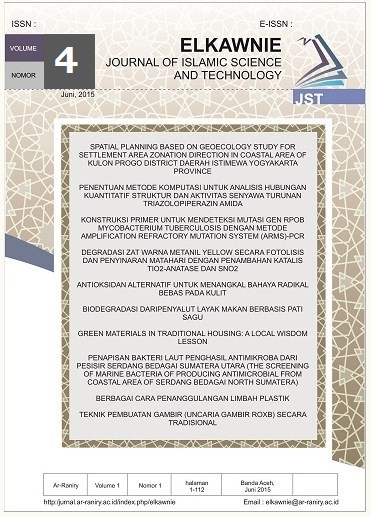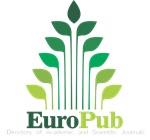Kajian Antagonisme Hara K, Ca Dan Mg pada Tanah Inceptisol yang Diaplikasi Pupuk Kandang, Dolomit dan Pupuk KCl terhadap Pertumbuhan Jagung Manis (Zea mays saccharata L.)
DOI:
https://doi.org/10.22373/ekw.v4i1.2751Keywords:
Nutrient Interaction, Nutrient Antagonism, Inceptisol SoilAbstract
Antagonism nutrient study for K, Ca and Mg in the Inceptisol soil that applied manure, dolomite and fertilizers KCl to the growth of sweet corn (Zea mays saccharata L.). The purpose of this research is to study the interaction between potassium fertilizer, dolomite and chicken manure on the growth of sweet corn (Zea mays saccharata L.) and assess the antagonism nutrient for K, Ca and Mg in the Inceptisol soil that applied manure, dolomite and fertilizers KCl against growing sweet corn (Zea mays saccharata L.). The result showed the interaction between potassium fertilizer, dolomite and chicken manure on the uptake of calcium, potassium and magnesium in plants sweet corn (Zea mays saccharata L.). There is antagonism nutrient calcium, potassium and magnesium plant sweet corn (Zea mays saccharata L.) on the ground Inceptisol that applied manure, dolomite and fertilizers KCl. The balance of the nutrient uptake of calcium, potassium and magnesium plant achieved at doses of potassium fertilizer at 100 kg K2O / haReferences
Anonim, 1992. Sweet Corn Baby Corn. Penebar Swadaya, Jakarta
Cooke, G.W. dalam Sari, S.G 2007. Pengujian Pengelolaan Hara Spesifik Lokasi pada tanaman jagung (Zea mays L.) di Tanah Andic Eutrudpth Kecamatan Tiga Binanga Kabupaten Karo.
Damanik, M.M.B., dkk. 2011. Kesuburan Tanah dan Pemupukan. USU Press.Medan
Gomez K.A dan A.A Gomez, 2007. Prosedur Statistik Untuk Penelitian Pertanian. Edisi Kedua. UI Press. Jakarta.
Grove, J.H., and .E. Sumner. 1985. Lime Induced Magnesiumstress in Corn:
Impact of magnesium and phosphorus avaiability. Soil Sci. Soc Am. J., Vol 49 : 1192 - 1196
Hanafiah, K.A. 2007. Dasar-dasar Ilmu Tanah. Raja Grafindo Persada. Jakarta
Ispandi Anwar dan Munip Abdul. 2004. Efektivitas Pupuk PK Dan Frekuensi
Pemberian Pupuk K Dalam Meningkatkan Serapan Hara Dan Produksi
Kacang Tanah Di Lahan Kering Alfisol. Jurnal. Ilmu Pertanian Volume.
No. 2, 2004 : 11-24.
Landon, J.R. (ed). 1984. Booker Tropical Soil Manual. Booker Agric. Intern.
Ltd.
Masud, P. 1992. Telaah Kesuburan Tanah.Angkasa. BandungPoerwowidodo. 1991. Genesa Tanah, Proses Genesa dan Morfologi. Rajawali
Press. Jakarta. 174 hal
Pusat Penelitian Tanah dan Agroklimat. 2000. Sumber Daya Lahan Indonesia Dan Pengelolaannya. Badan Penelitian Dan Pengembangan Pertanian Departemen Pertanian. Bogor.
Staff Peneliti Klasifikasi Tanah, 1990. Pusat Penelitian Kelapa Sawit. Medan
Stevenson, F.J. 1994. Humus Chemistry : Genesis, Composition, Reactions. 2th.ed.
John Willey and Sons, Inc. New York
Westeman, R.L. 1990. Soil Testing and Plant Analysis. Third Edition. Soil
Science Society of America, Inc. Madison. Wisconsin, USA.
Widijanto, H. 2001. Kajian Pemberian Bahan Organik dan Kapur Terhadap
Tahanan Borium serta Penyerapannya oleh Tanaman Jagung pada Ultisol
Jasinga. J. Penelitian Agronomi 3 (1) : 32-38
Wulandari, Vonny. 2011. Pengaruh Pemberian Beberapa Dosis Pupuk Kandang
Ayam Terhadap Pertumbuhan dan Hasil Tanaman Rosella (Hibiscus
Sabdariffa L.) Di Tanah Ultisol. Skripsi. Fakultas Pertanian, Universitas
Andalas Padang.
Downloads
Published
Issue
Section
License
Proposed Policy for Journals That Offer Open Access Authors who publish with the Elkawnie journal agree to the following terms:
a. Authors retain copyright and grant the journal right of first publication with the work simultaneously licensed under a Creative Commons Attribution License that allows others to share the work with an acknowledgement of the work's authorship and initial publication in this journal.
b. Authors are able to enter into separate, additional contractual arrangements for the non-exclusive distribution of the journal's published version of the work (e.g., post it to an institutional repository or publish it in a book), with an acknowledgement of its initial publication in this journal.
c. Authors are permitted and encouraged to post their work online (e.g., in institutional repositories or on their website) prior to and during the submission process, as it can lead to productive exchanges, as well as earlier and greater citation of published work (see The Effect of Open Access).

























